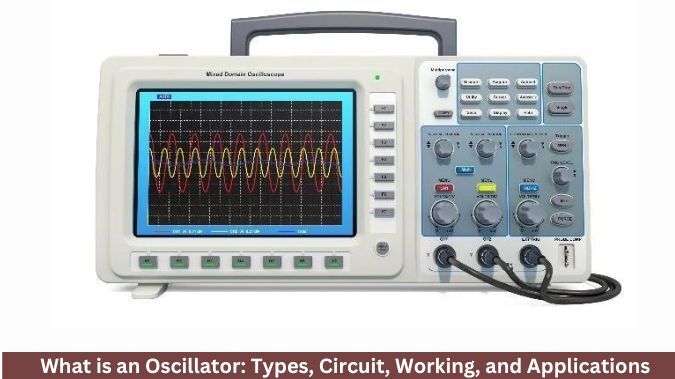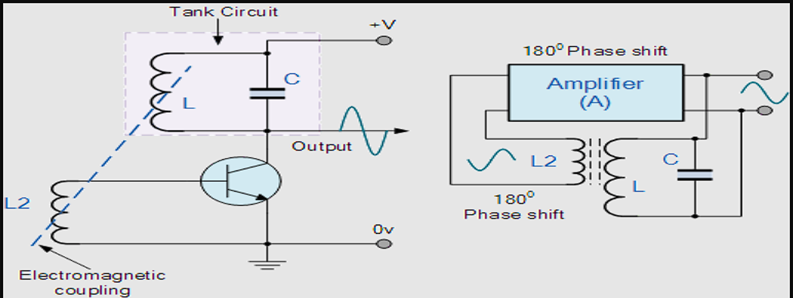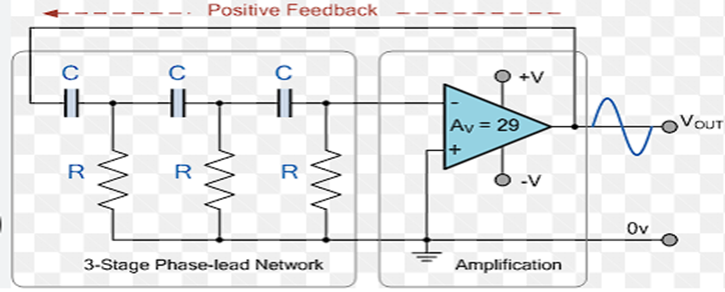
What is an Oscillator?
An oscillator is an electronic device that produces repetitive oscillating signals in the form of a sine wave, a square wave, or a triangle wave. Basically, this circuit converts DC (Direct Current) into an AC (Alternating Current) signal at a specific frequency.
An oscillator is essential in various electronic devices. It is used in Bluetooth modules for frequency generation and maintaining a stable connection. In relays, oscillators help with debouncing and pulse generation.
In sensors, they are used for generating carrier signals and stabilizing readings. Integrated circuits (ICs) use oscillators for clock generation and data synchronization. In connectors, oscillators assist with signal integrity and timing matching.
Microcontrollers rely on oscillators for peripheral operation and system clock management. Additionally, oscillators are used in LCD and LED displays for backlight control and data driving.
Oscillator Circuit

A basic oscillator circuit typically includes components like an amplifier stage, a feedback network, frequency-determining components, and a power supply.
1. Amplifier
An amplifier in an oscillator can be a transistor, an operational amplifier, or any active device that boosts small signals to maintain continuous oscillations. For that amplifier must provide a gain greater than or equal to one to sustain oscillations.
2. Feedback Network
In this network, it feeds a portion of the output back to the input with the correct phase. This network includes components like capacitive, inductive, or resistive networks like LC circuits or RC circuits.
3. Frequency Determining Components
This component sets the frequency at which the oscillator operates, which includes RC networks, LC networks, and crystal resonators.
4. Power Supply
It provides the necessary voltage and current for operation.
Types of Oscillators
Based on the design, frequency range, and application, oscillators are classified into various types. They are as follows:
1. LC Oscillator
An LC oscillator uses an inductor and a capacitor to determine the frequency of oscillation. It is a high-frequency operation oscillator that gives a smooth sine wave output, and its frequency depends on the values of L and C.
LC oscillator consists of different types like Hartley Oscillator (uses a tapped inductor), Colpitts Oscillator (uses a capacitive voltage divider), and Clapp Oscillator ( it is a variation of the Colpitts with an additional capacitor for better frequency stability.
It is mostly used in radio transmitters, RF communication circuits, and signal generators.

2. RC Oscillator
RC oscillator uses resistors and capacitors to produce oscillations. It produces stable low-frequency sine waves and is ideal for audio frequency generation, which is cost cost-effective design.
This includes the Wien bridge oscillator (for audio applications) and the Phase shift oscillator (produces sine waves using multiple RC stages). RC oscillators are used in audio signal generation, function generation, and low-frequency timing circuits.

3. Crystal Oscillator
To create a very stable frequency oscillation, a crystal oscillator uses the mechanical resonance of a quartz crystal. It generates a pure sine wave output with extremely high frequency stability. They have very low frequency drift due to temperature changes.
These are of the types Pierce oscillator and AT-cut crystal oscillator (widely used in microcontrollers). It is used in microcontrollers and microprocessors, Bluetooth and Wi-Fi modules, digital watches and clocks, and GPS systems.

Working Principle of Oscillator
The working principle of an oscillator is based on the concept of positive feedback and energy conversion from a direct current (DC) source into an alternating current (AC) signal at a specific, stable frequency.
The working of the oscillator is explained in step below:
1. Initial
Due to thermal activity, every electronic circuit has inherent noise, and this tiny noise signal acts as the seed for oscillation.
2. Amplification
At the amplification stage, the amplifier boosts this initial noise signal, and amplification must be sufficient to compensate for any losses in the feedback network.
3. Positive Feedback Loop
A portion of the output is fed back to the input in phase, which reinforces the input signal rather than cancelling it.
4. Frequency Selection
The frequency-determining network (RC, LC, or crystal) controls the frequency of oscillation.
5. Steady State Oscillation
As the feedback sustains the oscillations, the amplitude stabilizes. Non-linear effects or amplitude limiting mechanisms prevent the output from growing indefinitely, ensuring stable oscillations.
Applications of Oscillators
1. Communication Systems
- Oscillators generate high-frequency carrier signals for AM, FM, and digital modulation.
- Used to produce a range of frequencies from a single oscillator source.
- LC and crystal oscillators are used for tuning and frequency control.
- Example: Radio Transmitters, Mobile phones, Wi-Fi modules, Bluetooth devices
2. Microcontrollers and Microprocessors
Oscillators provide the clock signals needed for the timing and operation of microcontrollers and microprocessors. Crystal oscillators generate precise timing signals that ensure all processes operate in harmony and within correct timing constraints.
Example: Arduino boards, PIC microcontrollers, Embedded systems.
3. Sensors
Oscillators are used in sensor circuits for data acquisition and signal processing.
4. Display Technologies
Oscillators help maintain the refresh rate of digital displays. Used in the PWM (Pulse Width Modulation) circuits for adjusting display brightness.
Example: LED displays, LCD displays, OLED panels, Digital signage
Frequently Asked Questions
1. Is an Oscillator AC or DC?
An oscillator converts DC power into an AC signal by generating a continuous, oscillating waveform without an external input.
2. Is the Oscillator Negative or Positive?
An oscillator uses positive feedback to sustain continuous oscillations.
3. Which Oscillator is Better?
The crystal oscillator is considered better for applications requiring high-frequency stability and accuracy.
4. How Does an Oscillator Differ from an Amplifier?
An oscillator generates its own periodic signal without an external input, while an amplifier boosts the strength of an existing input signal.
5. What is the Difference Between RC and LC Oscillators?
An RC oscillator uses resistors and capacitors for low-frequency generation, while an LC oscillator uses inductors and capacitors for high-frequency generation.
6. What Causes an Oscillator to Fail?
An oscillator can fail due to component aging, temperature variations, power supply issues, or physical damage to the resonator elements, like crystals or inductors.
7. Can an Oscillator be Used as a Signal Generator?
Yes, an oscillator can be used as a signal generator to produce continuous waveforms like sine, square, or triangular signals.


